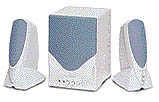Kenwood CL-701 3-piece Multimedia Speakers
by Mike Andrawes on April 6, 1999 7:44 PM EST- Posted in
- Smartphones
- Mobile
|
Quick Look |
||
|
Kenwood CL-701 |
The Good | |
|
|
+ Cool looking
design |
|
| The Bad | ||
|
- Higher fidelity at a lower price is not hard to
find |
||
Despite being one of the most popular brands at large consumer electronics stores, such as Circuit City, any hardcore audiophile will quickly tell you that Kenwood is not considered one of the top speaker brands. Kenwood's success is due to their low cost and quality that easily rivals anything else in its class, which includes names like Sony, Pioneer, and Aiwa.
With that in mind, it seems reasonable that Kenwood's foray into the multimedia speaker market would produce a product with similar advantages - quality good enough for most people at a reasonable price. Currently, two computer speaker sets are available from Kenwood - the CL-701 and CL-501. The CL-701 is a three piece speaker set consisting of a subwoofer and two satellites. The CL-501 features essentially the same set of satellites without a subwoofer.
The most important thing to keep in my mind when buying an audio equipment is that your ears are always the best judge because everyone has different musical tastes. Keep that in mind while reading speaker reviews and, if at all possible, listen to any speakers before making a purchasing decision.
Design
The first thing you will notice when unpacking the CL-701's is the cool looking design. Most multimedia speakers out there today are really plain looking, but these feature a sort of "space age" look with elegant cloth covers. The subwoofer features a wooden enclosure for improved bass response as well as the power, volume, bass, and SRS 3D sound controls. Unfortunately, if you put the sub on the floor, as most people do, you will constantly be crawling under your desk to adjust the volume. Of course, using the software volume control in Windows can prevent some time under your desk, but it will not help you when the phone rings and your scrambling to turn down the volume in that Quake deathmatch ;)
A giant AC adapter connects to the back of the sub to power the whole system. Fortunately, the power brick will not block any plugs on your surge protector thanks to separate cords to the wall outlet and sub. The satellites connect to RCA jacks on the back of the sub by 5ft cables that are permanently mounted to each satellite. The sub in turn connects to the computer by a 5ft patch cable featuring standard 1/8th inch plugs on each end. If your sound card uses RCA jacks for its line out, you will need to pick up an RCA to 1/8th headphone adapter. A nice touch is the availability of a line out on the back of the sub for hooking up another set of powered speakers without the use of adapters. A one page installation guide shows you everything you need to know to hook these speakers up in less than a minute.
The satellites use 2 x 3 inch drivers and a 4W RMS amplifier while the sub gets a 4 inch driver and a 12W amp. That RMS power rating is with a high 10% total harmonic distortion. This setup provides for a claimed 40Hz - 20kHz frequency response with a crossover at 75Hz that leaves the sub covering 40 - 75Hz and the satellites taking 75Hz - 20kHz. Human hearing ranges from 20Hz - 20kHz and few, if any, computer speakers make it all the way down to 20Hz. Many home speaker systems cannot make it that low either.











3 Comments
View All Comments
adnanspecter - Tuesday, April 19, 2022 - link
If you need, Kenwood CL-701 3-piece Multimedia Speakers check on https://specter.pk/.It is the best marketplace.
mkcosmetics - Thursday, May 12, 2022 - link
Also Need.https://www.mkcosmetics.com.pk/
freeonlinecourse - Tuesday, May 24, 2022 - link
Thanks for sharing,https://freeonlinecourse.net/